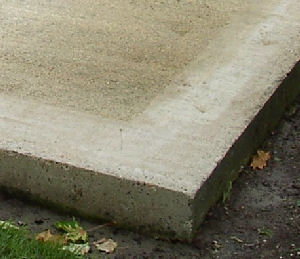Click this messge to hide it.
Log cabin base preparation and other information
Useful information

SIZE
The space will always be used, so buy the biggest building you can afford provided that it fits comfortably in the space available. There are no precise guidelines regarding the size. Often the size of the building is dictated by the space available. We offer a wide range of sizes to suit every space. If you are replacing an existing building, you should consider whether to have the same size again or perhaps larger. Also, consider what are the largest items you need to store.
LOCATION
Ideally your building should have a clear space at least 18" wide on all sides, if possible. This ensures easy access for both installation and future maintenance. In reality this is often not practical and at many sites it is not needed. A reduced clearance is often possible on one or two sides. If the space around your building is restricted remember to allow for any roof overhang. You should also cut back or remove any nearby shrubs and trees. Remember to allow for future growth. We recommend a sheltered position which is not exposed.
BASE
All buildings need a substantial base. The base should be solid, square, flat and level to ensure the stability of your building. Paving slabs or concrete are ideal. A solid concrete base is more permanent and normally more expensive but it provides an excellent base especially for a larger building. Paving slabs are more practical and cost effective, especially for a smaller base at the far end of the garden. The base should be no smaller than the floor size of the new building and no more than a few inches larger.
DELIVERY AND STORAGE
You will receive advance notice of the delivery day. Log cabins are bulky and heavy. A 3.0x3.0m log cabin pack is typically around 3.0m long, 1.2m wide, 0.7m high and 500 kilogrammes. A 5.0x5.0m log cabin pack is typically around 5.5m long, 1.2m wide, 1.0m high and 1000 kilogrammes. Larger multi room cabins may include 2 large packs weighing up to 2000 kilogrammes each. Log cabins are normally delivered to the front of the property where you will need a suitable storage area. At some sites the cabin can be left at the front for days or weeks if required but often this is not possible. It takes perhaps an hour or so to move a medium sized log cabin from the front of a typical property to the back. For the most part the logs and boards are not heavy and they can be carried one or two at a time. The doors and windows can be heavy especially if they are glazed in the factory and care is required. The thicker logs can also be heavy, even when carried one at a time. For example, a 6 metre long wall log 70mm thick may weigh up to 30 kilogrammes. Always keep the wall logs dry before assembly, especially the interlocking ends - if the ends are saturated they may not interlock properly.
DIY ASSEMBLY
Assembly is a straightforward and satisfying project for any DIY enthusiast. Even large buildings can be installed with only basic tools, such as a hammer, a screwdriver, a power drill, a spirit level, an adjustable spanner, a knife, a stepladder and safety goggles. Particular care is required when handling glass and good quality gloves should be worn at all times. You should not attempt to lift heavy sections without a helping pair of hands. Remember that extra time spent preparing a good base is normally repaid with time saved later on during the installation.
MAINTENANCE
The external timber should be treated with a good quality wood stain every year, including soon after installation. This will prolong the life of your building. All major wood stain manufacturers offer suitable products in a choice of colours, available at any good hardware shop. We also recommend that you regularly oil the door and window hinges as required to ensure continued smooth operation.
ELECTRICAL
Although providing an electricity supply to a garden building is normally a straightforward task, for safety reasons we recommend that you consult an approved electrician first. Since January 1st 2005 all electrical work must be completed in accordance with IEE wiring regulations and BS 7671. Notifiable work must be either notified directly to the local building control department or completed by an operator who is approved under the Part P Electrical Competent Person Scheme.
PLANNING
The majority of garden buildings do not require planning permission. However, permission is required for any building which covers over half the garden, which is not for domestic use or which is over 3 metres high with a pent roof or 4 metres high with an apex roof. Buildings which are within 2 metres of a boundary and over 2.5m high (8'2") require planning permission. Permission may also be required for any building which is nearer to a public highway than the original dwelling. For planning purposes a public highway includes any road or footpath with a public right of way. If you live in a Conservation Area or a Listed Building permission may be required for any garden building over 10 cubic metres. This brief summary is not intended to be a comprehensive guide. Contact us for further advice or contact your local planning department.
BUILDING REGULATIONS
The majority of garden buildings do not require approval under the building regulations. However, approval is required for any building with an internal floor area of more than 30 square metres.

